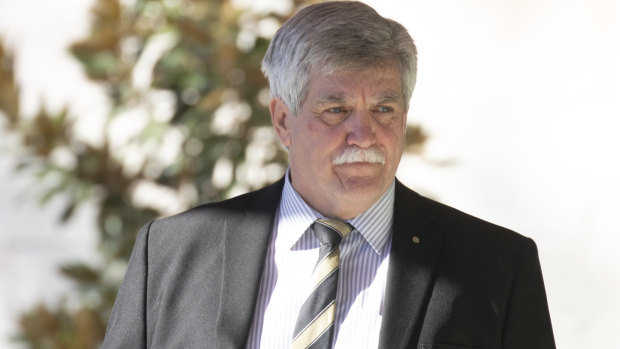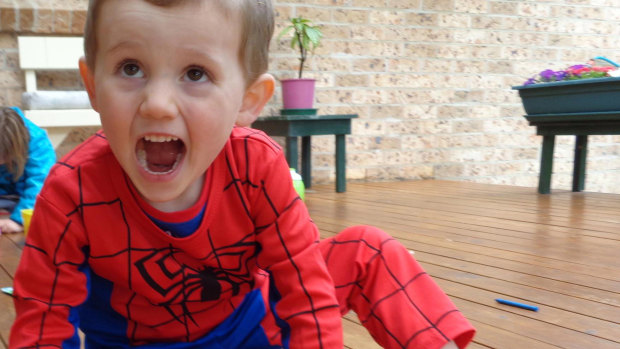This was published 4 years ago
Police will never give up on William Tyrrell investigation, inquest told
By Georgina Mitchell
The officer in charge of the investigation into William Tyrrell's disappearance has told an inquest that police have not given up on the missing toddler and "we never will".
William, 3, vanished from his foster-grandmother's home in the NSW Mid North Coast town of Kendall on September 12, 2014. An inquest in the NSW Coroners Court, which began last year, is examining his disappearance and suspected death.

Detective Chief Inspector David Laidlaw outside the Coroners Court last year.Credit: Renee Nowytarger
On Wednesday, Detective Chief Inspector David Laidlaw from the homicide squad told the court he took over the investigation in January 2019 after the previous officer in charge, Gary Jubelin, was removed.
Mr Jubelin was later convicted and fined $10,000 over illegally recording four conversations with Paul Savage, who was at one stage a person of interest in the case.
Counsel assisting the inquest Gerard Craddock, SC, asked Mr Laidlaw at the outset of his evidence: "Have you given up?"
"No," Mr Laidlaw said. "We never will."

William Tyrrell vanished in 2014 dressed in his Spider-Man suit.
Mr Laidlaw said active investigations were continuing in the case, which has seven investigators assigned including him, and police are due to go back into the field later this year. He declined to elaborate because "investigations are ongoing".
The police officer said that, when he took over the investigation, he decided not to get a handover or debriefing from Mr Jubelin and instead spoke to "every one" of the investigators on Strike Force Rosann, the homicide squad team investigating William's disappearance.
"My view at that stage was I was going to get more knowledge of the investigation from all those who worked on it, not just one person," Mr Laidlaw said.
Anna Baker, who told the inquest this week she heard a child scream from bushland the day after William disappeared, gave further evidence on Wednesday at the request of jailed paedophile Frank Abbott, who is watching the inquest from custody.
Abbott questioned Ms Baker about the distance she heard the scream from, whether it could have been a female child, and why she only reported it to the police about two years ago.
"I did hear a little boy scream, in the bush. You were the only person close to that bush and you’re a paedophile. You know something, Frank Abbott," Ms Baker said.
Ms Baker said she wants to know where William Tyrrell is, and Abbott responded that he is in the same boat.
"I’m not in your boat, mate," Ms Baker said.
Earlier on Wednesday, a memory expert told the inquest that a reported sighting of William in the back of a speeding four-wheel-drive on the day of his disappearance could have been a different child, or could have been William on an earlier day.
Ronald Chapman previously told the inquest he was at the front of his home on Laurel Street, near Benaroon Drive where William disappeared, about 10.45am on September 12 when he saw a woman speeding past with an unrestrained boy dressed in a Spider-Man suit in the back of her car.
"I definitely saw William. I'm 100 per cent sure it was William in the back of the car. No doubt," Mr Chapman said.
Dr Helen Paterson, a senior lecturer in forensic psychology at the University of Sydney, outlined research and literature on memory creation and retrieval and explained how memory operates, including how witness perception of an incident can be influenced by "post-event information" such as watching a news report.
Dr Paterson said Mr Chapman "originally wasn't very confident at all" about what he had seen and "wasn't sure if it was a dream", but became more confident over time that he had seen William.
She said it could be the case that Mr Chapman "saw a car go by with a child in it that was unrestrained" and later watched the news and incorporated William into his memory, or that he did see William on a completely different day and misremembered that he saw the speeding car on the day William went missing.
Dr Paterson said the recollection of William's foster mother, of seeing two parked cars on Benaroon Drive on the morning William disappeared, was "a possible false memory".
"There was a leading question at one stage - 'There weren’t any suspicious vehicles were there?' - that may have implanted in her mind … 'Were there suspicious vehicles?' " Dr Paterson said.
Dr Paterson said it is possible the foster mother saw the cars in that location at a different time and mistakenly believes they were there on the morning William disappeared.
The inquest continues.